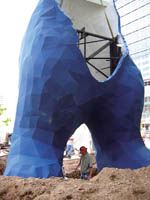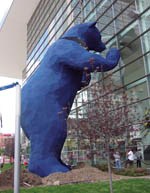Composite Sculpture Bears A Second Look
"Paperless" design and plug-free moldmaking enable cost-effective scale-up of miniature model to massive monument.
On June 23, composite sculpture was big news in Denver Colo., in more ways than one. As workers hoisted the head of artist Lawrence Argent's 12.2m/42-ft tall blue bear into place in front of the newly expanded Colorado Convention Center, they put the cap on an ambitious civic arts project made possible, in part, by an innovative design/fabrication process that enabled architectural composite fabricator Kreysler and Assoc. (American Canyon, Calif.) to machine molds for the massive art piece directly from the digital design files, without creating intermediate models and plugs.
Argent, an associate professor at the University of Denver, says that the height and scale of the sculpture fits the Convention Center building. "It's a matter of integrating it with the size of the building and the other sculptures already in place," he says. "Composite material was the only way this particular sculpture could be realized, and it likely couldn't have been done five years ago."
SCAN IN & SCALE UP
The bear evolved from a small plastic children's toy, which Argent scanned with a three-dimensional laser-scanning device from Cyberware Inc. (Monterey, Calif.). Like reverse engineering, the Cyberware device quickly converts a complex 3-D shape into a CAD computer file and is commonly used by artists and architects to digitize a shape for scaling to any size.
Because the small scan wasn't in the desired pose, Argent next used Lightwave, an animation software program from NewTek (San Antonio, Texas) to animate the image and reposition the figure. The animation software transformed the 3-D shape into hundreds of thousands of tiny triangles, using about 400,000 reference points, and creating movement by changing the triangles' shapes. Argent says he kept working with the virtual model to get just the right look and expression, gradually reducing or "decimating" the computer file down to a manageable 4,000 or so triangles forming the surface. At that point, the file was sent to a design firm, which employed a fused deposition modeling (FDM) rapid-prototyping machine manufactured by Stratasys (Eden Prairie, Minn.) to convert the computer animation file into a small 3-D scale-model plastic maquette, exactly at the scale of the architect's model of the building. The machine uses special software to digitally slice the 3-D computer shape into thin 2-D layers, then builds up a physical model by depositing thermoplastic particles in the shape of the 2-D layers that are stacked to form the 3-D shape. Because Argent liked the look of the triangles, he left them in the model. And, rather serendipitously, the FDM prototyping process employed a bright blue ABS plastic that so pleased the artist, he changed his presentation materials to fit the model's color.
Kreysler's role in the project was to take the computer data and fabricate the four-story 3-D structure, with its surface made up of thousands of faceted triangles of different sizes. Engineers imported Argent's animation file into RHINO software produced by Robert McNeel and Assoc. (Seattle, Wash.), which not only accepted the animation data but also was compatible with Kreysler's CNC machine controller.
"It dawned on us that the most efficient way to make this big 3-D figure was to use the computer model as the male plug, and generate the molds directly from the computer file, saving a step," says company president Bill Kreysler. Accordingly, the 4,000 triangles were grouped into "regions" that could fit into the CNC milling machine's work envelope, with no undercuts. Inexpensive expanded polystyrene (EPS) foam was machined to form female molds for the regions, each of which incorporated 40 to as many as 50 triangles. Because EPS foam material reacts with polyester resin, each mold was covered with aluminum foil, before application of a wax mold release.
Fabrication of parts for the regions began with a gel coat primer. Then multiple plies of 1.5 oz. chopped strand mat (CSM) from Saint-Gobain Vetrotex America (Valley Forge, Pa.) were wet out with polyester from Hexion Specialty Chemical (formerly Resolution Specialty Materials, Carpentersville, Ill.), hand layed into each mold and allowed to cure at room temperature.
BIG BEAR, LITTLE EXPENSE
To conserve material and reduce cost, Kreysler laminated as many parts as possible from each block of foam by re-machining blocks (when possible) to the shape for another region. About 80 individual parts were produced, at a finished thickness of about 6 mm/0.25 inch, including the gel coat.
Keeping track of the numerous panels and indexing them together was a challenge, reports Kreysler. "Again, the computer allowed us to take cross-sections through the bear at various heights and locations. We used plywood sheets to effectively create a horizontal bulkhead at various cross sections, and indexed the surrounding panels to the plywood."
Early on in the project, Kreysler planned to assemble all the panels in Denver, but as the pieces were fabricated and indexed, the impending complexity of the assembly process convinced Kreysler to prepare shippable subassemblies in California, then truck them to the Denver installation site for final assembly. Six major sections of the bear's body were identified for preassembly -- the left and right legs, the belly, the right and left arms with shoulders and the head. To ensure that the subassemblies could be fastened together securely at the job site, panels located adjacent to the major joints between subassemblies had to be modified to include a sturdy flange at the seam. Technicians fashioned the flanges by pressing a 130-mm/5-inch-wide strip of thin-gauge sheet metal into each seam panel's mold, at the part edge, at 90° to the mold face. The CSM layup plies were extended up the side of the metal strip, to form a robust 4-inch wide integral flange. Along the length of the flange, square indexers -- raised square shapes about 25.4 mm/1 inch wide -- were formed every few inches, to match depressed indexers in the mating flange seam, to ensure a positive fit during final installation. Argent was concerned about seam appearance on the finished piece, so seam locations were carefully mapped through the centers of triangles so that they occurred on flat, not angled, surfaces, to ensure a solid butt joint without any gaps.
Individual panels within each subassembly were simply butt-joined and overlaminated on both interior and exterior surfaces with additional plies of CSM/polyester. In a few key locations, the bulkheads used to index the panels were left in place to lend additional stiffness and strength to the subassemblies. The glassed joints on the bear's exterior were sanded and faired, then the six completed subassemblies were sprayed with a top coat of pigmented polymer concrete, based on a blue isopolyester gel coat matrix from Valspar Composites (Elkhart, Ind.) to which Kreysler added silica aggregate. The polymer concrete gives the sculpture a slightly rough finish, which together with the triangular facets lends significant texture to the piece. A final coating of clear automotive urethane was applied to help combat graffiti.
To provide a means of firmly attaching the sculpture to its foundation, a structural steel frame was welded inside each leg, extending upwards to about one-third of the bear's total height. The frame is attached to the inside of the legs with metal fasteners at locations built up with extra plies of CSM.
At this point, the six segments were trucked to Denver for final assembly and installation. A crane lifted the legs into position atop concrete footings with embedded steel rebar stirrups, to which the framework was bolted and welded. Each of the remaining subassemblies were craned into position, while technicians inside the bear's body joined the sections along the flanges, using steel bolts. An escape hatch at the top of the head allows access to the interior and gave technicians a way to climb out after bolting the head to the body.
Whimsically entitled "I See What You Mean," the bear appears to have to its paws against the Center's glass exterior, peering in at convention-goers. Kreysler notes that calculated wind loads were high enough that the paws actually are set back about 3 ft from the glass, to prevent the sculpture from striking the building. Total cost, including transportation, was about $450,000. "This is a unique and cost-effective way of creating a fiberglass structure, and probably the first time the direct-to-mold process has been used on something this large," says Kreysler.
Read Next
All-recycled, needle-punched nonwoven CFRP slashes carbon footprint of Formula 2 seat
Dallara and Tenowo collaborate to produce a race-ready Formula 2 seat using recycled carbon fiber, reducing CO2 emissions by 97.5% compared to virgin materials.
Read MoreVIDEO: High-volume processing for fiberglass components
Cannon Ergos, a company specializing in high-ton presses and equipment for composites fabrication and plastics processing, displayed automotive and industrial components at CAMX 2024.
Read MoreDeveloping bonded composite repair for ships, offshore units
Bureau Veritas and industry partners issue guidelines and pave the way for certification via StrengthBond Offshore project.
Read More



















